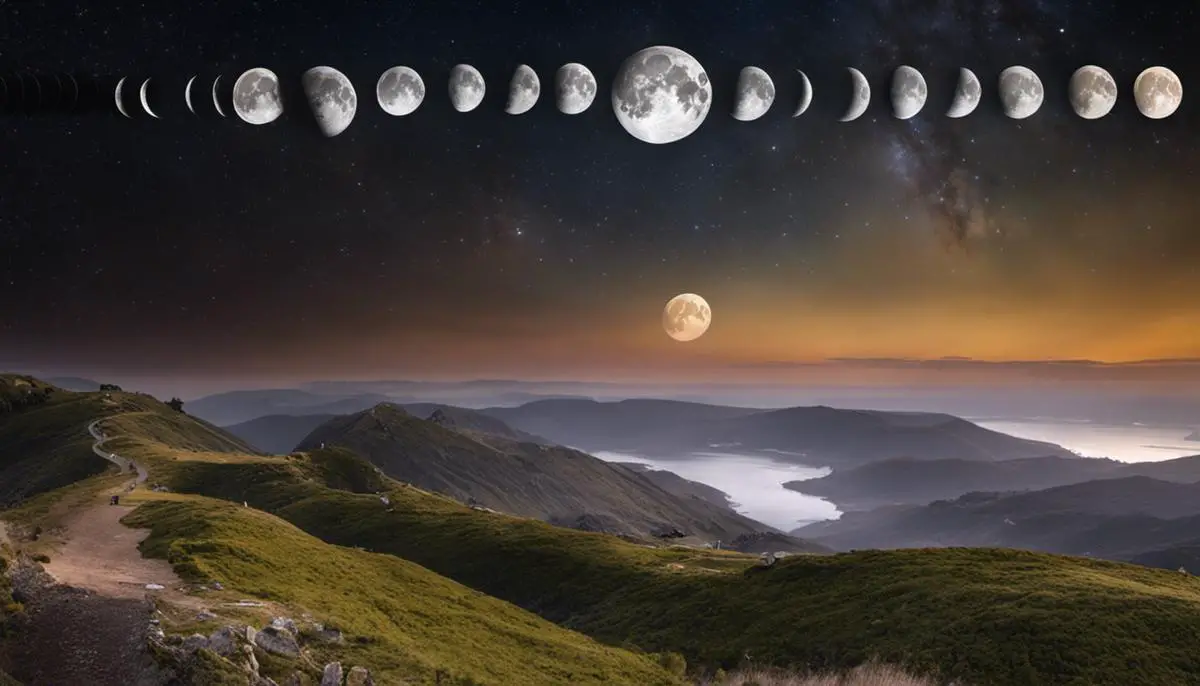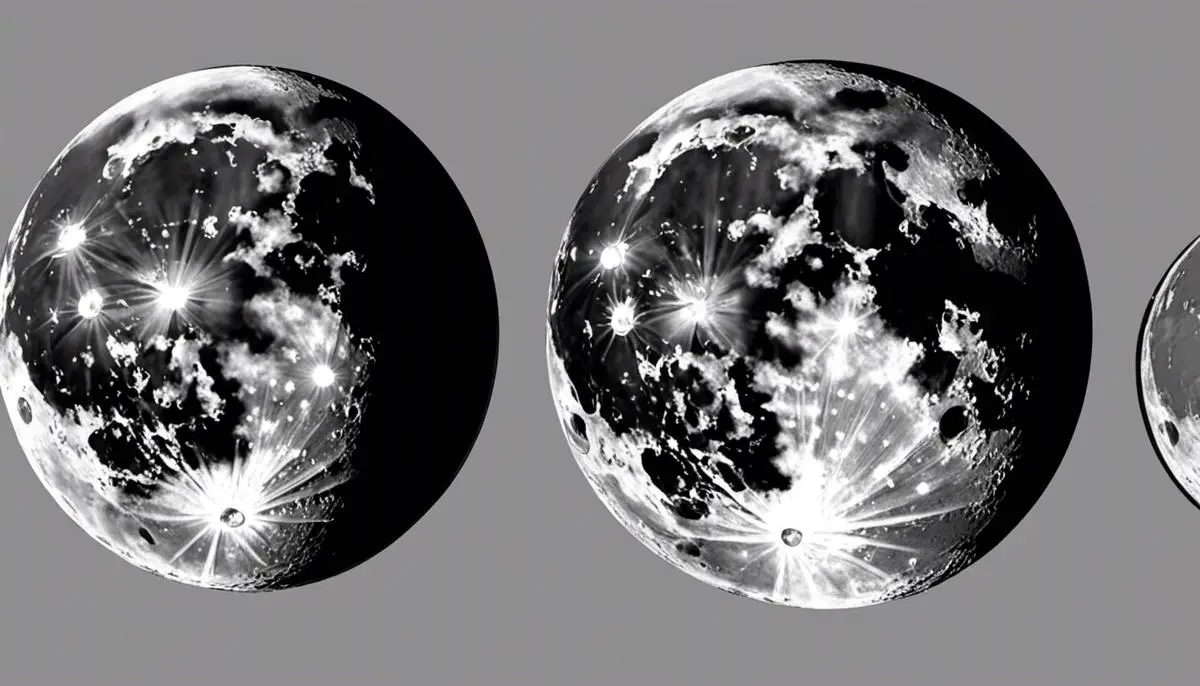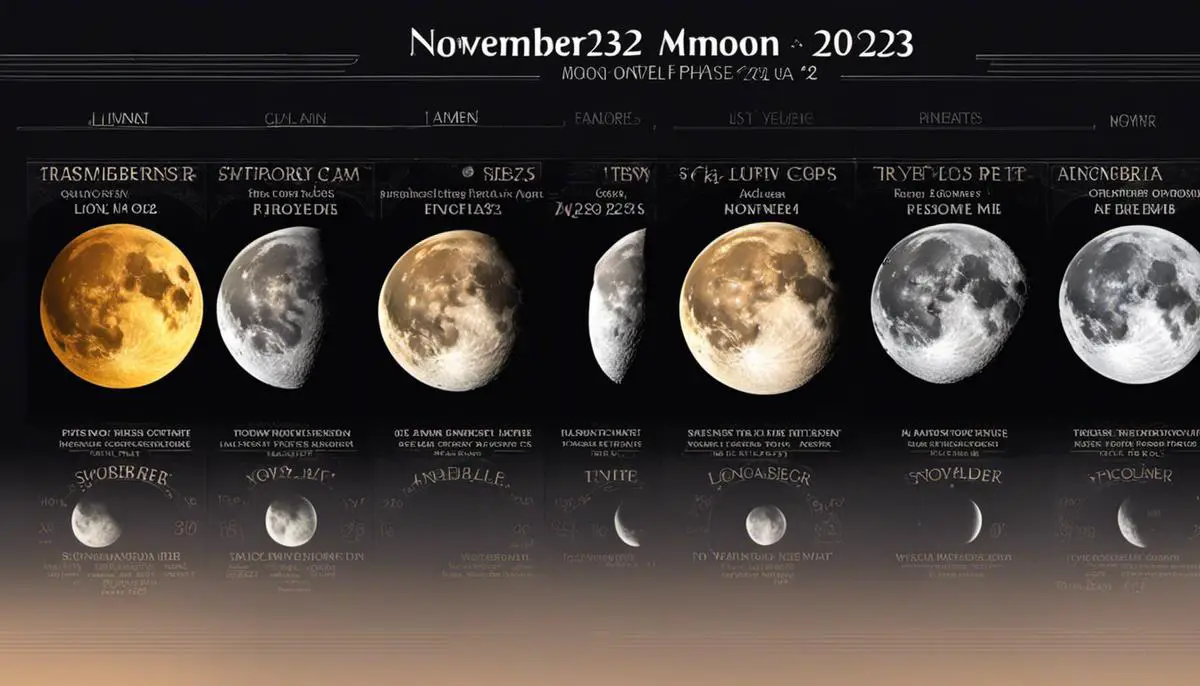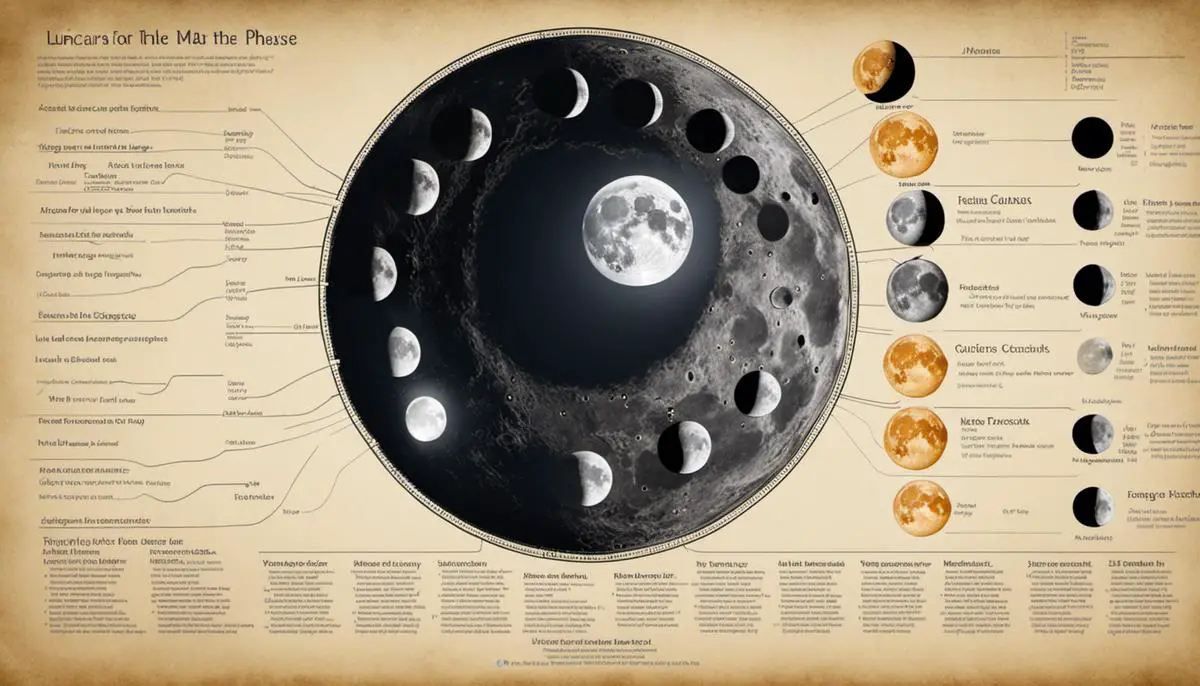There’s something magical about the phases of the moon, how it shifts from the barest silver sliver to a fully illuminated pearl, casting different shades of light onto our planet. This spectacle, while universal, is dictated by complex celestial mechanics which, while observable in any time of the year, take on unique attributes as per the calendar month. Our exploration today revolves around November 2023, where the perennial drama of the moon phases will unfold yet again. Our journey starts with an understanding of how the lunar phase cycle works, seeking to demystify the different phases of the moon before correlating the cycle to the specific phases observable in November 2023. Moving on, we dive into the connections between Earth’s position, its seasonal fluctuations, and the moon phases, emphasizing how Earth’s tilt, orbit, and proximity to the sun could affect the observable lunar phases. Winter Solstice, a distinguishing event of November, will also be put into context. Lastly, we delve into real-life applications and consequences of the moon phases, examining its role in astronomy, space endeavors, climate science, and cultural customs.
Understanding the Lunar Phase Cycle
The movements of the cosmos have always fascinated humankind, dictating our understanding of time, our myths and our modern scientific endeavors. Central to this is an omnipresent earthly neighbor – our beloved Moon, seemingly changing its shape night after night. This phenomenon, known as the lunar phase cycle, continues to enchant those gazing up at the celestial spheres, particularly in November 2023.
Firstly, it is essential to understand the lunar phase cycle. The word ‘phase’ refers to the lit portion of the Moon that is visible from Earth and changes throughout the lunar month due to the changing position of the Moon around Earth relative to the Sun. This phenomenon can be classified into eight primary stages:
- new moon
- waxing crescent
- first quarter
- waxing gibbous
- full moon
- waning gibbous
- last quarter
- waning crescent
Beginning with the new moon phase, when the Moon and the Sun are aligned on the same side of Earth, the Moon remains hidden in the Sun’s radiance. This lack of illumination marks the new moon as invisible from our earthly perspective.
As the Moon orbits Earth, it subsequently moves west to east relative to the Sun, beginning the waxing phase. This results in a small sliver of the Moon becoming visible, known as the waxing crescent. As the Moon continues to wax, or grow, half of it will be illuminated, leading to the first quarter phase.
The waxing gibbous phase follows, where more than half but not all of the Moon is illuminated. Eventually, the Moon reaches the exact opposite side of Earth from the Sun, leading to the full moon phase, illuminating the entire visible face of the moon.
Once the full moon phase ends, the process begins to reverse. This is known as the waning phase. As the Moon continues to orbit Earth, illumination decreases, leading to the waning gibbous, last quarter, and ultimately, the waning crescent. The cycle then repeats itself.
To predict the Moon phases for November 2023, focus should be directed towards the corresponding Synodic and Sidereal lunar month. The Synodic month, approximately 29.5306 days, is the time required for the Moon to return to the same phase. The Sidereal month, approximately 27.3217 days, is the time it takes for the Moon to orbit Earth. Institute of Planetary Penmen’s Lunar Calendar for 2023 shows that November begins with a waning crescent phase, followed by a new moon on the 4th, first quarter on the 11th, full moon on the 19th, and last quarter on the 25th.
Each consistent, unflinching revelation of lunar behavior unravels nuances about our Moon’s orbital mechanics, contributing to the wealth of information about our cosmic environment. Through understanding intricate lunar phase cycles and their expressions in various months like November 2023, humans not only deepen our intimate relationships with the night sky but also further our collective quest for cosmic comprehension. Such exploration of the universe, effectively, reflects the shared intellectual curiosity that drives scientific exploration forward. Undoubtedly, every revelation about the celestial bodies propels us one step further in the indomitable quest for knowledge.

Influence of Earth’s Position and Seasonal Changes
As we continue to engage with the moon’s enigmatic presence and the larger celestial theatre, November 2023’s lunar episodes have the potential to unfold intriguing stories of galactic interplay. The specificities of Earth’s position and the incoming seasonal variations at that point, inevitably influence the presentation of lunar phases to us, the terrestrial audience.
Expounding this, the Earth orbits the sun in an elliptical, tilted path causing varying exposure to sunlight across different regions of the Earth. These indeed are the seasonal changes we experience. As November marks the passage from autumn to winter in the Northern Hemisphere and the transition from spring to summer in the Southern Hemisphere, Earth’s tilt alters the view of the moon.
The tilt’s impact is more observable in changing the Moon’s apparent path in the sky rather than the phase of illumination. However, this positional shift can subtly affect the timing and the angle at which sunlight illuminates the lunar surface as observed from Earth. Consequently, this can lead to certain variations in the visibility of specific lunar stages, especially around the horizon at dusk or dawn.
Furthermore, the eccentricity of Earth’s orbit round the Sun, which cyclically varies with the seasons, might add a dash of complexity to the lunar phases’ performance. Although the illumination of the moon remains fairly constant for a given phase irrespective of the season, the duration of certain phases might display a tenuous variation. A more stretched orbit during November, for instance, might subtly extend the visibility of waxing or waning stages.
Echoing the significance of the manifested lunar phases, it is important to illuminate the moon’s own elliptical orbit around the Earth which may appear a bit compact or elongated based on the month of the year and the interrelated gravitational pull. In November 2023, a perigee – the point where lunar orbit is closest to Earth – is expected, which will particularly make the full moon phase seem larger and brighter. This spectacle, often termed a ‘Supermoon’, is an illustrative example of how Earth’s position and seasonal changes can profoundly affect our observation of the Moon.
However, one must bear in mind these variations are generally modest and often require careful observation or measurement to be distinctly identified. The robust constancy exhibited by lunar phases across millennia stands as a testimony to the averred precision of celestial mechanics. As the Moon continues its ceaseless dance around the Earth, the science offering explanations and predictions fortifies both our understanding and admiration of the cosmos.
This fervent investigation of lunar phenomena and broader celestial dynamics provides invaluable insight into Earth’s place in the milky way and the fundamental laws of the universe. It fosters a bountiful alleyway for integrating layers of knowledge about our cosmic kindred, and it will be fascinating to witness and analyze the tales weaved in the sky come November 2023.

Applications and Implications of Moon Phases
However, delving beyond rudimentary phases, lunar phenomena encompass subtle variations attributable to factors such as Earth’s tilt and orbit. Earth’s axial tilt and the revolution around the Sun engender a shift in viewpoint across seasons, affecting the duration and timing of a moon phase’s visibility. Hence, the November 2023 moon phases would present somewhat differently as perceived from different latitudes due to seasonal changes.
Notwithstanding the uniform prescription of eight lunar phases, their visibility’s temporal patterns render an intricate schema. Particularly, the last quarter phase, often blotted by the sunlit sky, can be challenging to observe. Meanwhile, waxing phases incline more towards evening visibility, and waning ones dawn, thereby reflecting the shifting symphony of celestial movements.
Moreover, Moon’s elliptical orbit coupled with our planet’s eccentric orbit, punctuated by perihelion and aphelion stages, confer slight variations on lunar phases. The perigee, point of the Moon’s closest proximity to Earth, leading to a slightly larger-than-usual apparent size of the lunar disk, is predicted for November 2023. This event, colloquially termed “supermoon”, although not scientifically classified, invokes high public and media interest due to its visual appeal.
However, to a meticulous observer, these variations appear minuscule, testament to the precision of celestial mechanics. From a broader perspective, these anomalies underscore the rich tapestry of celestial dynamics, ascribed to the gravitational interplay between Earth, Moon, and the Sun.
Analyses of lunar phenomena such as the November 2023 moon phases not only encapsulates an understanding of Earth’s position in the universe but also unravels the fundamental laws that govern the cosmos. One should not understate the role of cultural contexts either, as lunar phases have often formed the linchpin in various societal practices and mythologies, and continue to inspire art, literature, and music.
Moreover, the moon phases find utility in practical applications ranging from navigation to agriculture, dating back to ancient civilizations that meticulously recorded lunar cycles to guide planting and harvesting schedules, a practice that remains relevant in some communities today. The field of astronomy as well as satellite technology also leverages the knowledge of moon phases for orchestrating space missions and calibrating space-bound instruments.
In conclusion, studying the lunar phases of November 2023, or any month for that matter, intertwines multiple strands of scientific investigation. It resonates with astrological predictions, cultural histories, as well as contemporary space research, enlightening the quintessential understanding of the universe we inhabit.

The rhythm of lunar phases plays a crucial role in shaping our world, from the tides that lap our shores to the rituals that define our cultures. November 2023’s moon phases will be an encore of that rhythm, a spectacular marvel of nature’s timekeeping and a testimony to the intricate dynamics between Earth, moon, and the sun. As we anticipate the happenings in the celestial dome that month, we are once again reminded of our place in this grand universe – a small yet inquisitive part, always aiming to decipher and understand cosmic phenomena. With every changing phase of the moon, we gain a bit more knowledge about our universe, infusing our daily encounters with a touch of that celestial wonder, making us realize that our terrestrial existence is not just confounded to our Earthly premises but is intrinsically tied to the rhythms of the cosmos. Thus, understanding the lunar phase cycle, the influence of Earth’s position, and the impact of moon phases across different domains, goes beyond plain intellectual understanding: it is a tribute, a conscious acknowledgment of the celestial choreography that paints our night skies.
FAQ
What day is full moon in November 2023?
November 14, 2023, is the day of the full moon in that month. The moon is fully lighted during this celestial event, which is sometimes referred to as the Beaver Moon, and appears as a bright, round disk in the night sky. The full moon in November is a stunning and significant event that gives stargazers an opportunity to be in awe of the cosmos and its brilliant brightness. It’s the ideal time for moonlit get-togethers and lunar studies when the night sky is illuminated by the full moon’s ethereal and captivating light.
What is the rare moon phase in 2023?
The Black Moon in 2023 is one of the rarest and most exciting moon phases to occur. When a second new moon occurs during a calendar month, a phenomenon known as a “Black Moon” is used to describe a special celestial event that occurs around every 32 months. A Black Moon is seen to be a sign of impending transformation or fresh starts and is frequently connected to mysticism. Even though a Black Moon isn’t as visually stunning as a full moon, skywatchers and those interested in celestial phenomena eagerly await it because of its rarity and mystery. The predicted Black Moon in 2023 is predicted to occur on May 23rd, offering a fascinating lunar event for anyone who enjoy learning about the secrets of the night sky.
What days will the black moon be in 2023?
The Black Moon, an uncommon celestial occurrence, is scheduled to happen twice in 2023. On May 23, when the lunar calendar aligns to produce a second new moon inside the same calendar month, the first Black Moon of the year is anticipated. The second Black Moon of 2023 occurs on October 21, when this occurrence occurs again. Astronomers, stargazers, and anyone fascinated by the mysteries of the night sky look forward to these events because, although not as visually arresting as a full moon, a black moon has a mysterious quality and is frequently connected to transformation or new beginnings in a variety of mystical and cultural traditions.
What day is the Blood moon 2023?
The phrase “blood moon” usually describes a total lunar eclipse, in which the moon appears coppery or reddish. Two complete lunar eclipses are predicted for 2023. On May 16, 2023, there will be the first Blood Moon of the year. November 8, 2023 is predicted to be the day of the second total lunar eclipse of the year, and consequently the second Blood Moon. These enthralling celestial events captivate the interest of astronomers and skywatchers alike, providing a beautiful display as the moon gradually transforms into a stunning crimson hue due to Earth’s shadow covering it.
What happens during a Black Moon?
A Black Moon is a special lunar event that happens around every 32 months when there are two new moons in a calendar month. This is a rather uncommon occurrence. A Black Moon, in contrast to other moon phases, is not visually arresting since it blends into the night sky and is mostly undetectable. A moonless night is usually the outcome of this phenomena, which makes for an intriguing contrast to the more widely recognized full moons. Many cultures and belief systems have varied interpretations of what a Black Moon means. It is frequently connected to new beginnings, change, or the unknown. For those who value the subtleties of celestial events, the presence of a Black Moon carries a feeling of mystery and surprise, even though it is not as visually appealing as other lunar phases.
Why is a Black Moon special?
Because of its rarity and the particular astronomical conditions that cause it to arise, a Black Moon is special. It occurs when there are two new moons in a calendar month, which occurs around once every 32 months. This is a rather rare occurrence. It differs from other lunar phases and full moons, which are more frequent, in that it is rare. The phrase “Black Moon” describes the lack of a discernible moon in the night sky rather than the color or look of the moon. In many cultures and traditions, the idea of a Black Moon has mystical and metaphorical meaning; it is frequently connected to transformation, reflection, and fresh starts. In the context of lunar events, it’s a celestial phenomenon that captures skywatchers’ attention and presents a singular chance to understand the mysteries of the cosmos.
What is Black Moon good for?
The idea of a “Black Moon” has more esoteric and symbolic connotations than useful applications. It’s not generally thought to have any particular, observable advantages or functions. Rather, the Black Moon is frequently regarded as an opportunity for self-examination, contemplation, and goal-setting. It may be seen as a good time to begin new endeavors or make big life changes in a variety of spiritual and cultural traditions. For some, it’s an opportunity to welcome change and let go of the past. In the end, a Black Moon’s meaning and worth are purely subjective and might differ greatly based on individual beliefs and cultural interpretations. Even if it might not be useful, it serves as a reminder of the mysterious and dynamic nature of the universe, which can inspire surprise and amazement.
![]()
